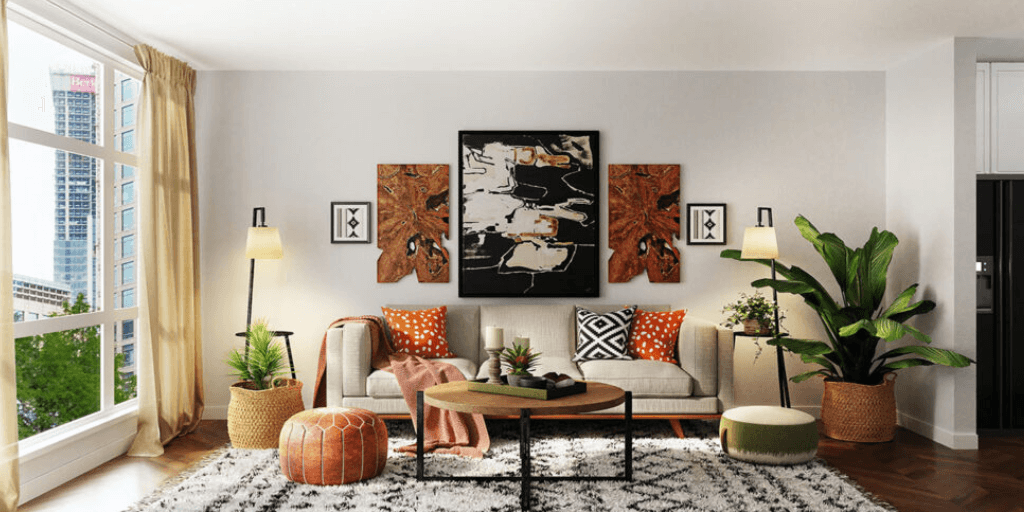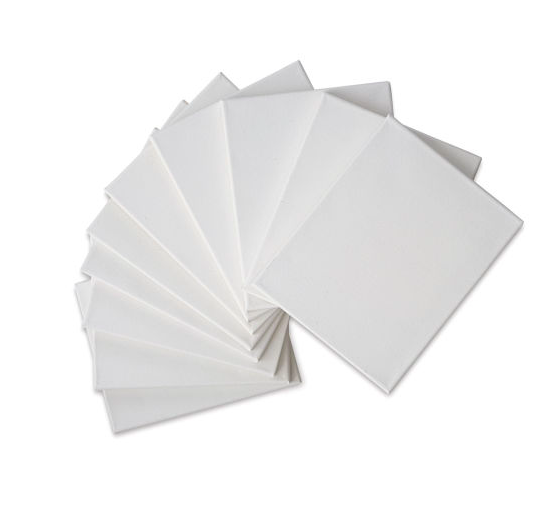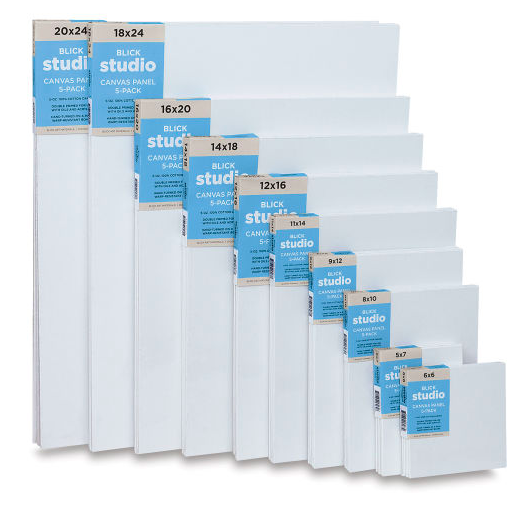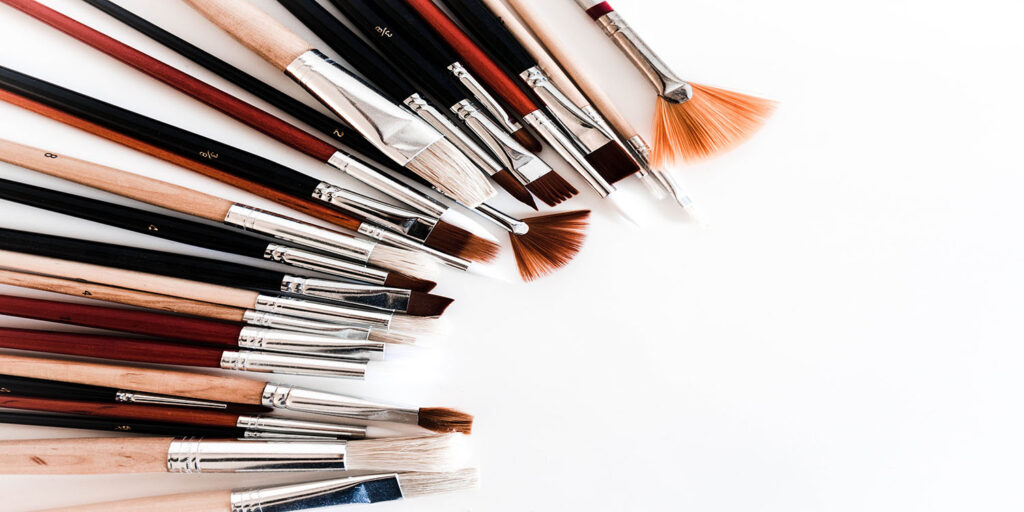
This page contains affiliate links. Meaning, I get a small commission if you purchase through my links, at no extra charge to you. Read the full disclosure here
What is Canvas?
Canvas is a versatile painting surface used by artists for several generations and remains the top choice for painting among artists even today.
It is generally made from either linen or cotton that are woven together and then stretched over a frame or glued to a panel.
It comes in a range of surfaces, sizes, and grades to meet any need or budget.
Things to know before purchasing canvas for painting.
Aside from deciding the right canvas size for your artwork there are a several other things to take into consideration before buying canvas.
Quality of Fabric
There are two types of canvas that are most popular and used by artists all over the world . These are canvases made of Linen and Cotton. Choosing the right canvas for your painting depends upon your requirement and the level of experience you have as an artist.
We will briefly discuss the difference between both of these fabrics here.
Linen Canvas
Linen canvas is made from the fibers of a flax plant that are durable and rigid. Linen is a more expensive option, primarily due to the best quality fibers being grown in western Europe.
The threads that make up linen, known as warp and weft threads weigh the same and are less prone to expansion and contraction due to moisture. This makes linen much more expensive than cotton canvas. Linen canvas retains its natural oils preserving the fiber’s flexibility and your art.
It is more often the choice of many established artists. If you are an artist starting out or are in the beginning stages of your artists’ journey, it is better to give some time experimenting on cotton canvas, instead of investing in linen canvas.
Cotton canvas
Cotton is a soft, fluffy fiber that stretches easily and is mass-produced in Africa, America, and India. It is affordable and stretches very easily. Cotton duck canvas is the most common and cheapest variety of canvas.
The advantage to cotton canvases is that they are easier to stretch as a result, and are more affordable. Cheap quality cotton canvas can absorb moisture and could gradually deteriorate over the decades.
Texture of canvas
The texture of the canvas is determined by the weave of thread that makes up the canvas. If the weaves are closely tied and are finely woven then the surface would be smooth and it is an ideal choice for smaller, detailed work. If the weaves are rough, then it is ideal for large brush strokes, ideally for larger paintings.
Priming
In order to avoid the paint being absorbed by the canvas, most of the canvas is being primed with gesso. This will give a smoother look to the canvas and shows the exact color on the canvas.
Alternatively, if you are looking for a more textured look for your paintings, you might also get a canvas that is not primed.
Once you have decided on the type of canvas, you need to determine the size you want to start your painting on. This is a personal choice and largely depends on the theme or purpose of your painting.
If you are looking to create a bold statement piece for a large wall, a bigger canvas might be the best choice. On the other hand, for smaller, detailed work or something more intimate, a smaller canvas could be the perfect choice.
Which size of canvas should I buy?
In order to answer this, you need to have a clear idea of what kind of artwork you are about to start.
For instance, if you’re about to start a series, you might want to choose medium sized canvas between 8″ x 10″ and 16″ x 20″. On the other hand, if you would like to go for a large abstract painting, then choosing a larger canvas board will be an ideal option.
As a beginner artist, it is advisable to try out several sizes of cotton canvas to understand what size works best for you.
Sizes of Canvas
Mini canvas

Mini canvases are those that are used for creating very small paintings. This usually comes in packs. The variation of sizes would be 2″ x 2″ or 3″ x 3″.
Small Canvas

Smaller canvases are great for working on fine detailed work .It comes in sizes .
- 4″ x 6″
- 5″ x 7
Rectangle canvases–Medium to Large

Rectangle canvases come in many different variations and are one of the most common and sought choices of artists. The sizes for this canvas differs from medium to large painting.
- 8″ x 10″
- 9″ x 12″
- 11″ x 14″
- 12″ x 16″
- 18″ x 24″
- 20″ x 24″
- 24″ x 36″
- 30″ x 40″
- 36″ x 48″
Square canvases

The square size canvas may start from the smallest mini canvas which is 2″ x 2″
- Mini sizes (under 4″ x 6″)
- 8″ x 8″
- 10″ x 10″
- 12″ x 12″
- 20″ x 20″
Types of Canvases
Canvas Rolls
Canvas rolls are sold either through the yard or by the roll. This is a perfect choice if you prefer to do large paintings.
The canvas is stretched to the wooden panel before beginning the painting and is a great option if you are an experienced artist . Since this comes in a roll, it would be a bit difficult for a beginner artist as it requires you to prepare the canvas, mount it on the wooden panel and prime it before you start your painting.
However if you are interested to try out the canvas roll, you could buy in small yards and see if it works for you. Blick Art is offering canvas rolls in yards. It is acrylic primed and you could purchase in yards based on your requirement and see if it works for you.
Canvas Pads
These are sheets of primed canvas cut into sheets and bound into pads. Canvas pads are portable and are great for quick sketches. The finished artwork can be framed in the same way as stretched canvases or canvas panels.
Stretched canvas
Stretched canvas is one of the most popular types of canvas for painting. The canvas is stretched over a frame, stapled to the thin or thick wooden frame when you purchase it.
This is best for artists who do not want to waste their time stretching the canvas on their own. It is usually completely primed and ready to paint.
Canvas Panels
Canvas panels are ideal for starters as they are lightweight, easy to carry, and are really cheap compared to other options. These are usually thick panels cut into the desired size and canvas or linen sheet mounted on top of the board.
To conclude, choosing the right canvas is an important decision when it comes to painting.
It can greatly impact your creative process and the final result.
It does not really matter even if you are just a beginner or an experienced artist. Understanding the types of canvases, the textures, and how they are prepared would be really helpful in making the right choice before you invest in one.
From linen and cotton to stretched canvas and canvas rolls, each option offers unique advantages to suit your needs.
Investing in the right canvas not only enhances your artwork but also ensures it lasts for a much longer period without discoloration, fading or any other damage.
Remember that Art is not just about the final piece- it is a beautiful journey. Choosing the right canvas is an essential part of that process.





